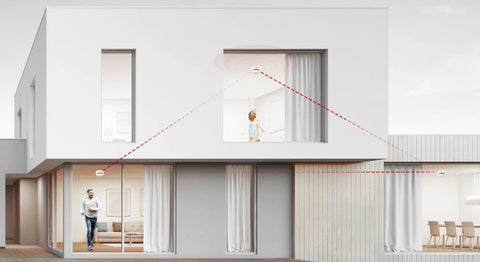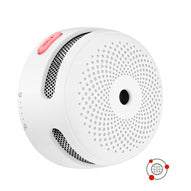What Is Wireless Interconnected Photoelectric Smoke Alarm?
Wed, Mar 31, 2021
Interconnected photoelectric smoke alarm for homes and businesses is not only an excellent tool to prevent theft and intrusion, but it helps you protect what matters most to you against accidents and emergencies of all kinds.
An interconnected photoelectric smoke alarm is capable of detecting smoke in the environment and triggering an alert even when the alarm is deactivated. This alert serves, in the first place, to warn those who are in the home or business in which a fire is taking place since it incorporates a bell to launch acoustic warnings and a system of colored lights that inform about the status sensor.
Let us find out more about the interconnected photoelectric smoke alarm in the following:
What Is a Wireless Interconnected Photoelectric Smoke Alarm?

Wireless interconnected Photoelectric smoke alarm connects using some sort of wireless signals. Typically, it will be a personal Wi-Fi network or using radio signals.
Also, the smoke detector communicates bidirectionally by radio frequency, so it transmits the smoke alert to the control panel that, thanks to its wireless transmission route, sends it to our Alarm Receiving Center, the largest and most advanced.
In this way, an interconnected photoelectric smoke alarm is the best system to prevent fires in kitchens, garages, warehouses, or rooms with chimneys.
How Does It Work?
A connected smoke detector is equipped with home automation sensors, which, when activated, immediately send a message to your home automation box. This can then warn you, in real-time, of the triggering of the smoke detector. Some models operate independently: they are not connected to a box and notify you directly in the event of an alert.
On a technical level, smoke detectors are equipped with an optical chamber with LED which constantly checks the transparency of the air. If the environment is made opaque, by smoke or water vapor, the detector triggers the alarm.
Smoke detectors should therefore be placed well away from sources of steam, such as bathrooms or kitchens. It is also advisable to disconnect them in case of work, to prevent dust from triggering them unnecessarily. Note, the most advanced models today know how to distinguish between water vapor and smoke.
Using a light-emitting device (LED) directed towards an area that is not "observed" by a photosensitive element or photodiode, the smoke particles can enter the path of the light. This falls on these particles and is reflected or refracted on the photodiode activating the detector. When the measurements exceed the alarm limit, the detector will trip giving a warning signal to the controller panel.
What Are the Benefits of an Interconnected Photoelectric Smoke Alarm?
When your smoke detectors are interconnected, they communicate with each other and forms an integrated system for your home protection.
It interconnects via hardwired models’ wires or wirelessly using radio signals. If any of the alarms detect smoke, all other interconnected alarms will start sounding.
For instance, if there will be a fire in the basement, you won’t be able to hear the sound from there. And if you will use an interconnected photoelectric smoke alarm, they all will start signaling at once when there is smoke detected in your home.
The Advantages of the Wireless Interconnected Photoelectric Smoke Alarm:
- You receive a message wherever you are in the event of a smoke signal. You are therefore notified in real-time, even when you are not at home.
- The alarm can be silenced with a single click and remotely, eliminating the need to deactivate it from the housing.
- The home automation detector warns you when its batteries are flat. You don't need to check them.
- It can be multifunctional: detect carbon monoxide, check the air quality. It then becomes the ally of your health in addition to that of your home automation security.
- Coupled with a camera, it allows you to quickly differentiate between a real and a false alarm.
- Coupled with an alarm system with assistance service, it alerts the emergency services if you are unable to react.
Best Wireless Interconnected Photoelectric Smoke Alarm: X-Sense XS01-WR Review
If you are looking for the best interconnected photoelectric smoke alarm, we recommend going with the XS01-WR model. The company extends its wireless line with a new member. This is the XS01-WR smoke detector that will allow you to complete security solutions in homes, offices, warehouses, and anywhere where smoke detection is required, combined with a security system against intruders.

X-Sense XS01-WR Wireless Smoke Detector
- Wireless technology uses radio frequency to transmit and receive messages.
- If one alarm goes off, the rest of the interconnected alarms will alert as well.
- 5-year replaceable battery and 10-year sensor life.
- Advanced photoelectric sensor is more sensitive and reduces false alarms.
$29.99
The wireless photoelectric interconnected smoke detector has been designed to detect smoke particles entering the sensor chamber and thus provide early warning of fires in progress.
It can generate a wireless signal to the alarm panel, thus being able to report the event through programmed means; Likewise, it has a built-in interconnected smoke alarm system that allows a quick alert at the event.
This model, connected to a landline telephone socket, is connected via WiFi throughout the house and therefore offers you interaction via a mobile or tablet application.
In this way, the detector notifies you directly in the event of a problem but also informs you of the first steps to be taken. A significant advantage if you take into account that the time to react in the event of a fire is extremely limited. This intelligent XS01-WR smoke detector may represent the future of fire protection.
This model offers many great advantages. First of all, their installation can be done at any time. Also, the absence of wires makes them more aesthetic and more practical.
The system is scalable, additional detectors or other devices can be added to the network. Finally, if you move, you can take your detectors with you and reinstall them.
However, it is important to know that radio waves have a limited range and that there are materials that hinder their diffusion. This type of device is therefore recommended in dwellings with an area of fewer than 100 m2 and preferably on one level.
Two-way Wireless System:
In two-way wireless systems, not only will the smoke detector be able to send an information packet to the alarm panel, but the panel will also be able to respond with the necessary information and thus establish a link that will help the system to solve the deficiencies conventional systems have.
Being a wireless detector compatible with the KPD-860RF keyboard, it has an anti-collision protocol, automatic power control, and very high sensitivity, which will allow the detector to cover long distances.
Features:
- Covers your entire home/office.
- Wireless interconnection.
- Advanced photoelectric sensor.
- Multifunctional test and silence button.
- 5-year replaceable batteries.
How to Choose Your Interconnected Photoelectric Smoke Alarm?
Are you convinced by the connected version of the smoke detector? Here are the right questions to ask yourself before you buy.
- Which model is compatible with my home automation box? Check that the information transmission mode is understood by your home automation box. If you don't have a home automation box, choose a stand-alone model, which works alone with a specific smartphone application.
- How many sensors are needed to cover my entire home? If you live in a large house, choose models that offer interconnectable detectors.
- What features do I need? If you have a fireplace or gas boiler, the carbon monoxide home automation sensor is very useful. Otherwise, you can save it. Likewise, humidity or air quality sensors are more or less useful depending on the region.
- What equipment should my detector interact with? The simpler models will not be able to be connected to your connected alarm system, for example.
FAQs
We know you still have some questions in your mind, so here we have answered the most frequently asked questions.
Do smoke detectors need to be interconnected?
Government mandates a minimum necessity for smoke detectors. However, the Fire and Rescue department recommends you install a higher level of protection with wireless interconnected Photoelectric Smoke Alarm installed in living spaces and bedrooms (including stairways and hallways and even in the garage).
Can battery smoke alarms be interconnected?
Yes, all battery smoke alarms can be interconnected. XS01-WR is already a battery smoke detector and can be easily interconnected.
How do you silence an interconnected smoke detector?
For wireless or hardwired detectors, only silencing the initiating system will silence all other connected alarms. The smoke detector is desensitized by pushing the “Hush/Test” button which you will find on the smoke detector cover. In case of smoke is not that dense, the detector will get silent immediately.
Conclusion
With home automation, the smoke detector, mandatory in all homes, ensures your safety even better. In addition to triggering the alarm, the wireless interconnected photoelectric smoke alarm sends you an alert on your smartphone.
Some models can even notify the emergency services if you are absent! So, this is a very useful device that you should not miss installing in your home and/or office.
You may also like: What is the Benefit of Wireless Interconnect Smoke Alarm







